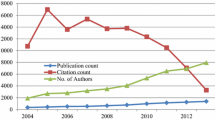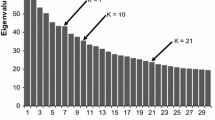Abstract
Based on data from the Web of Science, international collaboration between China and the UK in food and agriculture has been investigated from various perspectives. A new method for classifying cross- or multi-disciplinary fields has been created. The comparative study focuses on China’s collaboration with selected countries including the USA, the UK, Germany and Japan. The newly proposed Integrated Impact Indicator (I3) is applied to evaluate publication impact. Although China’s total publications dropped in 2010, its research productivity in food and agriculture nevertheless kept growing and international collaboration, reflected by the number of publications, also increased in an exponential way. The growth rate of China’s internationally collaborated publications was lower than that of China’s total publications. The USA, Japan, Canada, Australia, the UK and Germany are the top partners for Chinese researchers in this field. China-UK joint publications overall increased although their share in China’s total internationally collaborated publications decreased. To China, collaborating with the USA, the UK and Germany, instead of Japan, seems to offer an option to raise impact. The rapidly growing number of international publications and impact of Chinese research in food and agriculture offers great collaboration potential for the country. The fact that the average impact of China-UK collaborative publications is higher than the domestic publications of either country implies that collaboration benefits both sides as has been found in several other studies.












Similar content being viewed by others
Notes
British Embassy Beijing: UK science and innovation. Available at: http://ukinchina.fco.gov.uk/en/about-us/working-with-china/science-innovation-network/science-and-innovation/UK-science-and-innovation/.
References
Aksnes, D. W. (2003). Characteristics of highly cited papers. Research Evaluation, 12(3), 159–170.
Arunachalam, S. (2000). International collaboration in science: the case of India and China, web of knowledge—a festschrift in honor of Eugene Garfield: ASIST monograph series (pp. 215–231). Medford: Information Today.
Cho, C. C., Hu, M. W., Liu, M. C., et al. (2010). Improvements in productivity based on co-authorship: a case study of published articles in China. Scientometrics, 85(2), 463–470.
deB Beaver, D., & Rosen, R. (1978). Studies in scientific collaboration, Part I. The professional origins of scientific co-authorship. Scientometrics, 1, 65–84.
deB Beaver, D., & Rosen, R. (1979). Studies in scientific collaboration, Part II. Scientific co-authorship, research productivity and visibility in French scientific elite, 1799–1830. Scientometrics, 2, 133–149.
France Research Councils UK (2008). UK–China research collaborations: what can bibliometrics tell us?
Glänzel, W. (2001). National characteristics in International Scientific Co-authorship. Scientometrics, 51(1), 69–115.
Glänzel, W., & Schubert, A. (2001). Double effort = double impact? A critical view at international co-authorship in chemistry. Scientometrics, 50(2), 199–214.
Glänzel, W., & Schubert, A. (2005). Domesticity and internationality in co-authorship, references and citations. Scientometrics, 65(3), 323–342.
He, T. W. (2009). International scientific collaboration of China with the G7 countries. Scientometrics, 80(3), 571–582.
ISTIC (2009–2011). 中国科技论文统计结果 (Statistical Data of Chinese S&T Papers), Beijing. Available at: http://www.istic.ac.cn/tabid/640/default.aspx. Accessed 4 Jan 2013.
Katz, J. S., & Hicks, D. (1996). A systemic view of British Science. Scientometrics, 35(1), 133–154.
Katz, J. S., & Hicks, D. (1997). How much is a collaboration worth? A calibrated bibliometric model. Scientometrics, 40(3), 541–554.
Leydesdorff, L., & Bornmann, L. (2011). Integrated impact indicators compared with impact factors: an alternative research design with policy implications. Journal of the American Society for Information Science and Technology, 62(11), 2133–2146.
Ma, Z. Z., Lee, Y., & Chen, C. F. P. (2009). Booming or emerging? China’s technological capability and international collaboration in patent activities. Technological Forecasting and Social Change, 76(6), 787–796.
Narin, F., Stevens, K., & Whitlow, E. S. (1990, June 14–15). Scientific cooperation in Europe and the citation of multinationally authored papers. Paper presented at the international conference on output indicators for evaluation of the impact of European community research program, Paris, 14–15 June 1990.
National Bureau of Statistics of China (2012). Statistical Bulletin for the National Science and Technology Investment in 2011. http://www.stats.gov.cn/tjgb/rdpcgb/qgrdpcgb/t20121025_402845404.htm. Accessed 25 October 2012.
National Science Board (2010). Globalization of science and engineering research: a companion to science and engineering indicators 2010. Arlington: National Science Foundation. http://www.nsf.gov/statistics/nsb1003/. Accessed 4 Jan 2013.
Opthof, T., & Leydesdorff, L. (2010). Caveats for the journal and field normalizations in the CWTS (“Leiden”) evaluations of research performance. Journal of Informetrics, 4(3), 423–430.
Persson, O. (2010). Are highly cited papers more international? Scientometrics, 83(2), 397–401.
Royle, J., Coles, L., Williams, D., & Evans, P. (2007). Publishing in international journals—an examination of trends in Chinese co-authorship. Scientometrics, 71(1), 59–86.
Schubert, A., & Braun, T. (1990). World flash on basic research: international collaboration in the sciences, 1981–1985. Scientometrics, 19(1–2), 3–10.
Schubert, A., & Glänzel, W. (2006). Cross-national preference in co-authorship, references and citations. Scientometrics, 69(2), 409–428.
Spaan, J. A. E. (2010). The danger of pseudoscience in informetrics. Journal of Informetrics, 4(3), 439–440.
Sun, J., Liu, H., Wang, L., et al. (2010). Contributions of international cooperation projects to the HIV/AIDS response in China. International Journal of Epidemiology, 39(2), 1114–1120.
Tang, L., & Shapira, P. (2011a). China–US scientific collaboration in nanotechnology: patterns and dynamics. Scientometrics, 88(1), 1–16.
Tang, L., & Shapira, P. (2011b). Regional development and interregional collaboration in the growth of nanotechnology research in China. Scientometrics, 86(2), 299–315.
The Royal Society (2011). Knowledge, networks and nations Global scientific collaboration in the 21st century. London, ISBN: 978-0-85403-890-9.
Tijssen, R. J. W., Visser, M. S., & Van Leeuwen, T. N. (2002). Benchmarking international scientific excellence: are highly cited research papers an appropriate frame of reference? Scientometrics, 54(3), 381–397.
Van Raan, A. F. J. (1998). The influence of international collaboration on the impact of research results—some simple mathematical considerations concerning the role of self-citations. Scientometrics, 42(3), 423–428.
Ye, X. T., Liu, Y., & Porter, A. L. (2012). International collaborative patterns in China’s nanotechnology publications. International Journal of Technology Management, 59(3–4), 255–272.
Zheng, J., Zhao, Z. Y., Zhang, X., et al. (2011). International scientific and technological collaboration of China from 2004 to 2008: a perspective from paper and patent analysis. Scientometrics, 91(1), 65–80.
Zhou, P., & Glänzel, W. (2010). In-depth analysis on China’s international cooperationin science. Scientometrics, 82(3), 597–612.
Zhou, Ping, & Leydesdorff, Loet. (2006). The emergence of China as a leading nation in science. Research Policy, 35(1), 83–104.
Zhou, Ping & Loet Leydesdorff (2008). China ranks second in Scientific Publications since 2006, ISSI Newletter, Nr. 13, pp. 7–9.
Zhou, P., & Zhong, Y. F. (2012). The citation-based indicator and combined impact indicator—new options for measuring impact. Journal of Informetrics, 4(6), 631–638.
Acknowledgments
The study was supported by National Natural Science Foundation of China (NSFC) with grant number 71073153 and the Global Partnerships Program of the Department for Business, Innovation and Skills (BIS) of the UK.
Author information
Authors and Affiliations
Corresponding author
Rights and permissions
About this article
Cite this article
Zhou, P., Zhong, Y. & Yu, M. A bibliometric investigation on China–UK collaboration in food and agriculture. Scientometrics 97, 267–285 (2013). https://doi.org/10.1007/s11192-012-0947-7
Received:
Published:
Issue Date:
DOI: https://doi.org/10.1007/s11192-012-0947-7




